A New Method for Determining Critical Irrigation Period for Large Regions Based on Precipitation-Meteorological Yield Integral Regression Relationship—A Case Study of Winter Wheat in Shaanxi Province, China
Abstract
:1. Introduction
2. Methodology
2.1. Comprehensive Partition Method and Data Acquisition of Precipitation and Yield in Subregion
2.2. Decomposing Method of the Trend Yield and Meteorological Yield of Each Subregion
2.3. Solving the Precipitation-Meteorological Yield Integral Regression Function of Each Subregion
3. Results and Discussion
3.1. Natural Characteristics and Water Deficit Distribution of Winter Wheat in Different Subregions
3.2. Trend Yield and Meteorological Yield of Winter Wheat in Typical Counties
3.3. Optimum Irrigation Period of Winter Wheat
3.4. Discussion
4. Conclusions
- (1)
- Compared with the optimal irrigation period determined by the previous small area experiment, the method proposed in this study has the advantages of small workload and strong timeliness. It can overcome the shortcomings of the previous test method that the result is not stable, due to the small test area and the lack of representativeness.
- (2)
- The irrigation periods of winter wheat in subregions I and II are the overwintering and jointing periods, the irrigation period in subregion III is in the middle of the overwintering period, and the irrigation period in subregion IV is the early overwintering period, which is basically consistent with irrigation habits of local farmers, and can be used to guide the irrigation of local winter wheat. It also demonstrates that the method proposed in this paper has important application value in determining the deficit irrigation period with small water amount, in a large region lacking in research materials.
Author Contributions
Funding
Conflicts of Interest
References
- FAO. Aquastat Database. 2015. Available online: http://www.fao.org/nr/water/aquastat/main/index.stm (accessed on 22 April 2015).
- Huang, J.; Li, Y.; Fu, C.; Chen, F.; Fu, Q.; Dai, A.; Shinoda, M.; Ma, Z.; Guo, W.; Li, Z.; et al. Dryland Climate Change: Recent Progress and Challenges. Rev. Geophys. 2017, 55, 719–778. [Google Scholar] [CrossRef]
- Burney, J.A.; Naylor, R.L.; Postel, S.L. The Case for Distributed Irrigation as a Development Priority in Sub-Saharan Africa. Proc. Natl. Acad. Sci. USA 2013, 110, 12513–12517. [Google Scholar] [CrossRef] [PubMed]
- FAO. Kenya Brief: Global Information and Early Warning System. 2017. Available online: http://www.fao.org/giews/countrybrief/country.jsp?Code=KEN/main/index.stm (accessed on 29 July 2017).
- Dile, Y.T.; Karlberg, L.; Temesgen, M.; Rockstrom, J. The Role of Water Harvesting to Achieve Sustainable Agricultural Intensification and Resilience against Water Related Shocks in Sub-Saharan Africa. Agric. Ecosyst. Environ. 2013, 181, 69–79. [Google Scholar] [CrossRef]
- Zhao, X.N.; Wu, P.T.; Feng, H.; Wang, Y.K.; Shao, H.B. Towards Development of Eco-Agriculture of Rainwater-Harvesting for Supplemental Irrigation in the Semi-Arid Loess Plateau of China. J. Agron. Crop Sci. 2009, 195, 399–407. [Google Scholar] [CrossRef]
- Baguma, D.; Loiskandl, W. Rainwater Harvesting Technologies and Practises in Rural Uganda: A Case Study. Mitig. Adapt. Strateg. Glob. Chang. 2010, 15, 355–369. [Google Scholar] [CrossRef]
- Freni, G.; Liuzzo, L. Effectiveness of Rainwater Harvesting Systems for Flood Reduction in Residential Urban Areas. Water 2019, 11, 1389. [Google Scholar] [CrossRef]
- Adekalu, K.O. Adapting Crop-Yield Models to Irrigation Scheduling in Nigeria. Food Rev. Int. 2004, 20, 309–328. [Google Scholar] [CrossRef]
- Jones, H.G. Irrigation Scheduling: Advantages and Pitfalls of Plant-Based Methods. J. Exp. Bot. 2004, 55, 2427–2436. [Google Scholar] [CrossRef] [PubMed]
- Neupane, J.; Guo, W.X. Agronomic Basis and Strategies for Precision Water Management: A Review. Agron. Basel 2019, 9, 21. [Google Scholar] [CrossRef]
- Roy, P.C.; Guber, A.; Abouali, M.; Nejadhashemi, A.P.; Deb, K.; Smucker, A.J.M. Crop Yield Simulation Optimization Using Precision Irrigation and Subsurface Water Retention Technology. Environ. Model. Softw. 2019, 119, 433–444. [Google Scholar] [CrossRef]
- Kropp, I.; Nejadhashemi, A.P.; Deb, K.; Abouali, M.; Roy, P.C.; Adhikari, U.; Hoogenboom, G. A Multi-Objective Approach to Water and Nutrient Efficiency for Sustainable Agricultural Intensification. Agric. Syst. 2019, 173, 289–302. [Google Scholar] [CrossRef]
- Li, F.W.; Yu, D.; Zhao, Y. Irrigation Scheduling Optimization for Cotton Based on the Aquacrop Model. Water Resour. Manag. 2019, 33, 39–55. [Google Scholar] [CrossRef]
- Boughton, W.; Droop, O. Continuous Simulation for Design Flood Estimation—A Review. Environ. Model. Softw. 2003, 18, 309–318. [Google Scholar] [CrossRef]
- Pham, M.T.; Vernieuwe, H.; De Baets, B.; Willems, P.; Verhoest, N.E.C. Stochastic Simulation of Precipitation-Consistent Daily Reference Evapotranspiration Using Vine Copulas. Stoch. Environ. Res. Risk Assess. 2016, 30, 2197–2214. [Google Scholar] [CrossRef]
- Cho, J.; Shin, C.M.; Choi, H.K.; Kim, K.H.; Choi, J.Y. Development of an Integrated Method for Long-Term Water Quality Prediction Using Seasonal Climate Forecast. Proc. Int. Assoc. Hydrol. Sci. 2016, 374, 175–185. [Google Scholar] [CrossRef]
- Pei, S.X.; Guo, Q.S.; Jia, Y.B.; Xin, X.B.; Ge-Xi, X.U. Integral Regressive Analysis on the Responses of First Flowering Date of Eight Woody Species to Climate Change in Baoding, China. J. Beijing For. Univ. 2015. [Google Scholar] [CrossRef]
- Deng, Z.Y.; Yin, X.Z.; Yin, D.; Yang, Q.G.; Zhu, G.Q.; Liu, M.C. Study on Eco-Climatic Applicability of Angelica Sinensis. China J. Chin. Mater. Med. 2005, 30, 889. [Google Scholar]
- Gu, J.X.; Yuan, M.X.; Liu, J.X.; Hao, Y.X.; Zhou, Y.T.; Qu, D.; Yang, X.Y. Trade-Off between Soil Organic Carbon Sequestration and Nitrous Oxide Emissions Fromwinter Wheat-Summer Maize Rotations: Implications of a 25-Year Fertilization Experiment in Northwestern China. Sci. Total Environ. 2017, 595, 371–379. [Google Scholar] [CrossRef] [PubMed]
- Workneh, F.; O’Shaughnessy, S.; Evett, S.; Rush, C.M. Relationships between Early Wheat Streak Mosaic Severity Levels and Grain Yield: Implications for Management Decisions. Plant Dis. 2017, 101, 1621–1626. [Google Scholar] [CrossRef] [PubMed]
- Jaleta, M.; Hodson, D.; Abeyo, B.; Yirga, C.; Erenstein, O. Smallholders’ Coping Mechanisms with Wheat Rust Epidemics: Lessons from Ethiopia. PLoS ONE 2019, 14, e0219327. [Google Scholar] [CrossRef] [PubMed] [Green Version]
- Wu, S.R.; Jia, X.T. Agricultural Resources Survey and Agricultural Regional Reporting Collection of Luochuan County, Shaanxi Province; Xi’an Map press: Xi’an, China, 1985; pp. 200–202. [Google Scholar]
- Su, F.C. Planting Resources and Zoning in Shaanxi Province; Shaanxi Science and Technology Press: Xi’an, China, 1986; pp. 322–374. [Google Scholar]
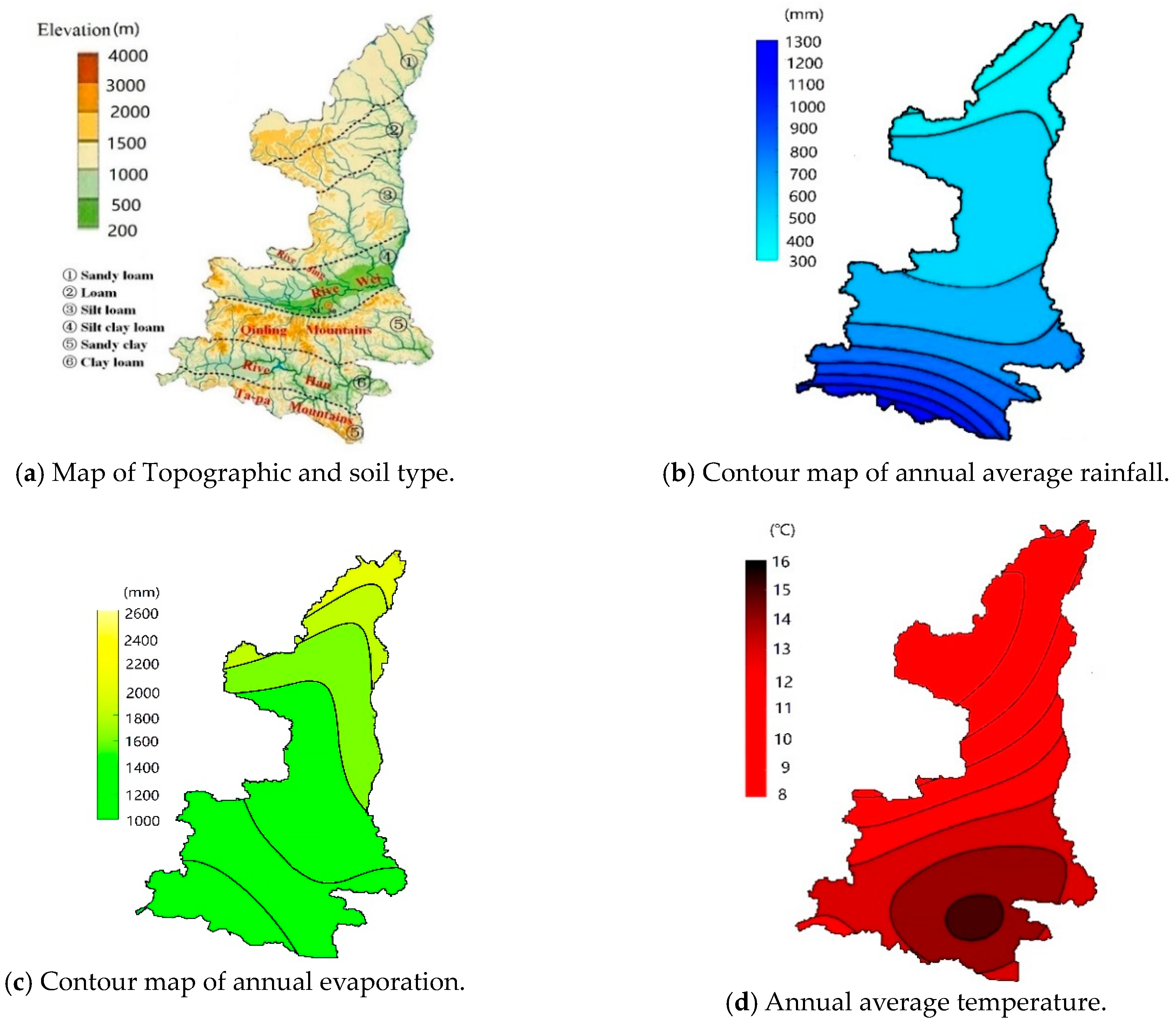
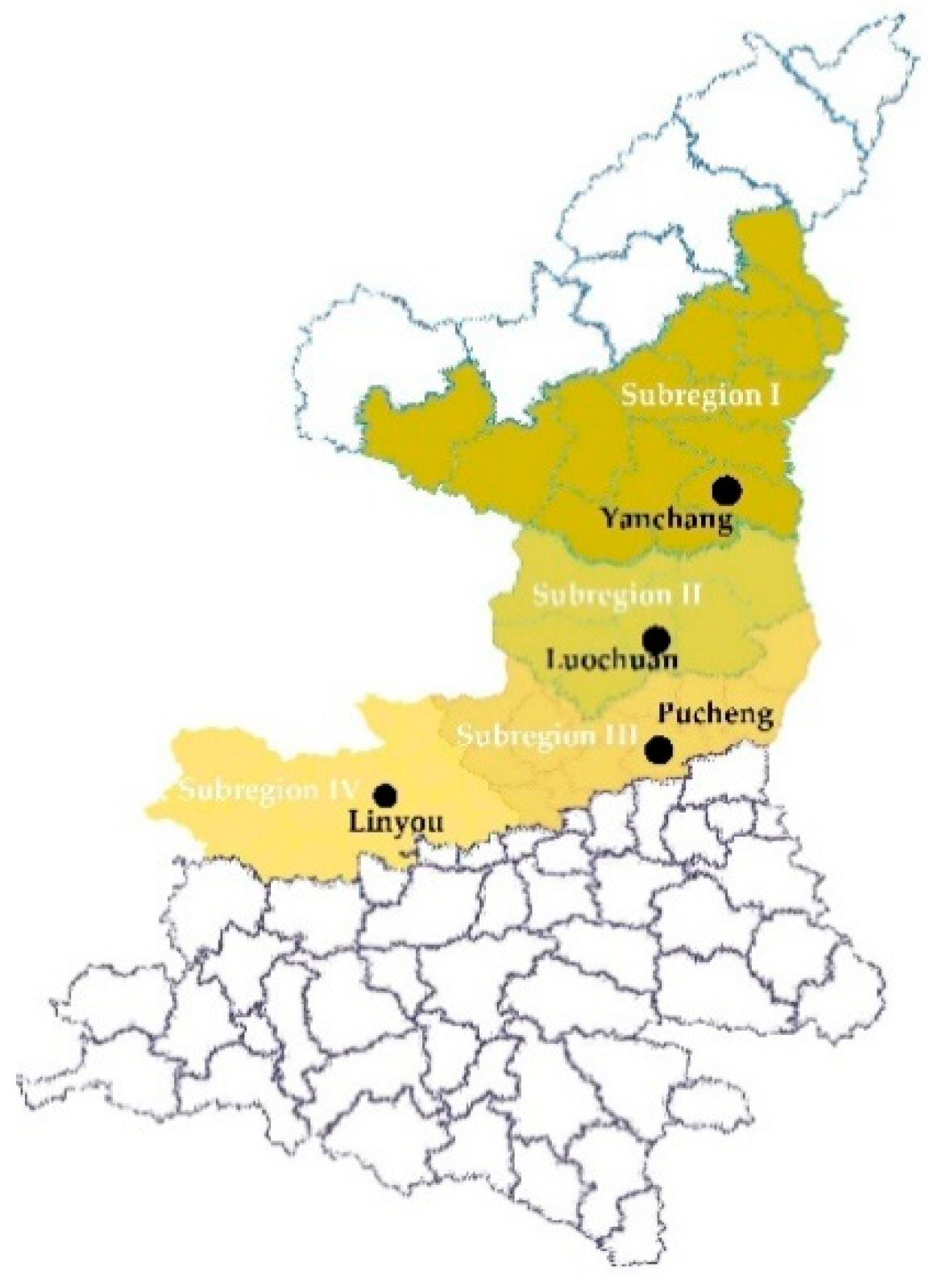
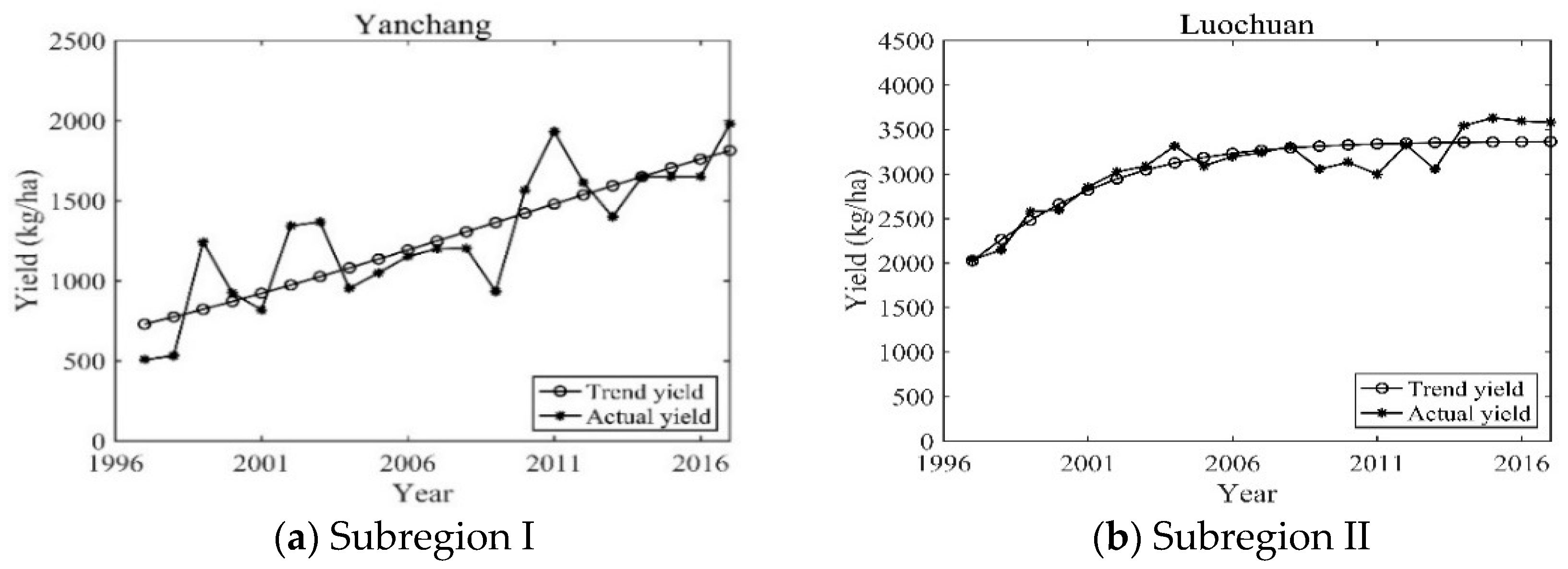

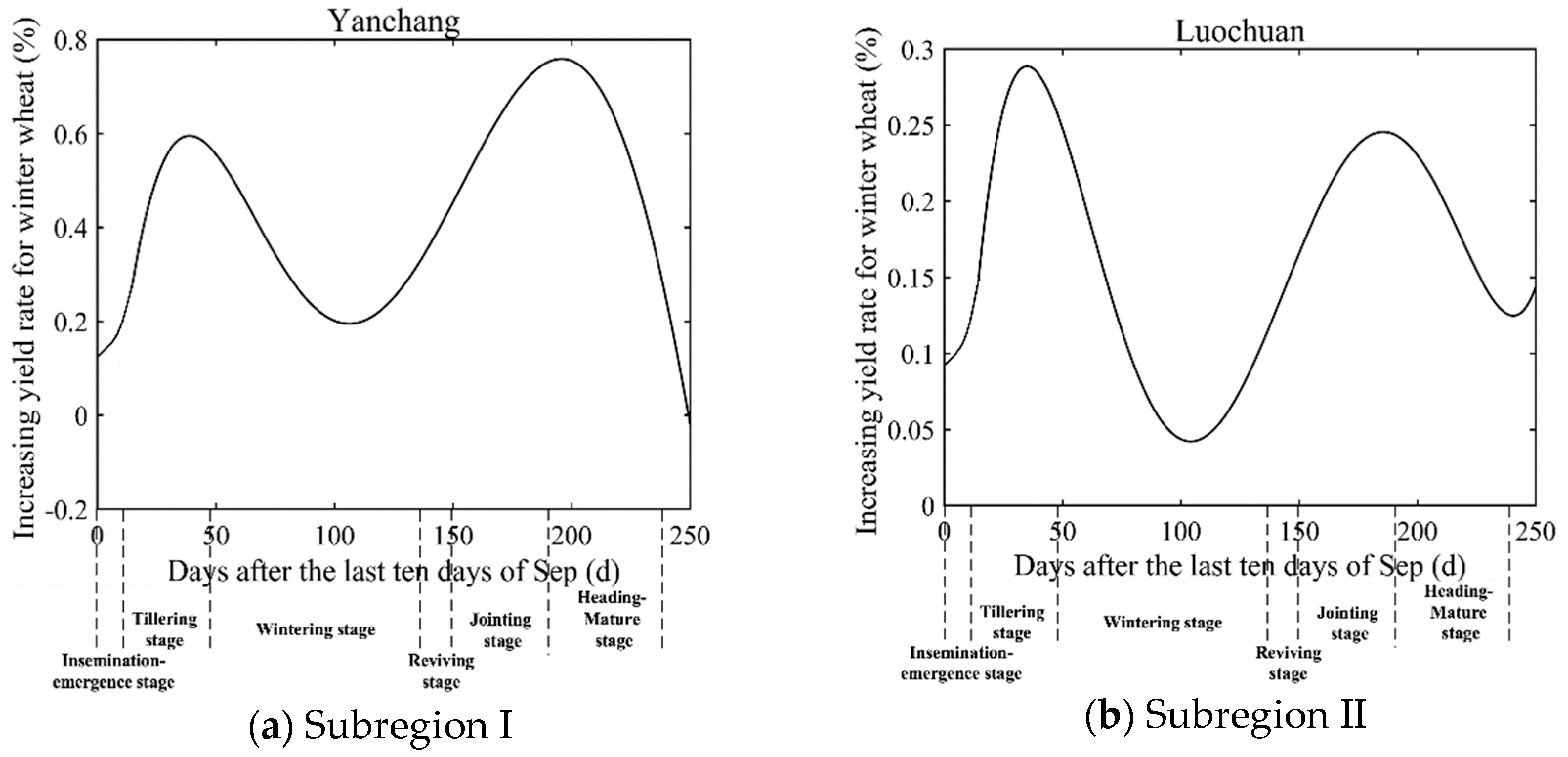
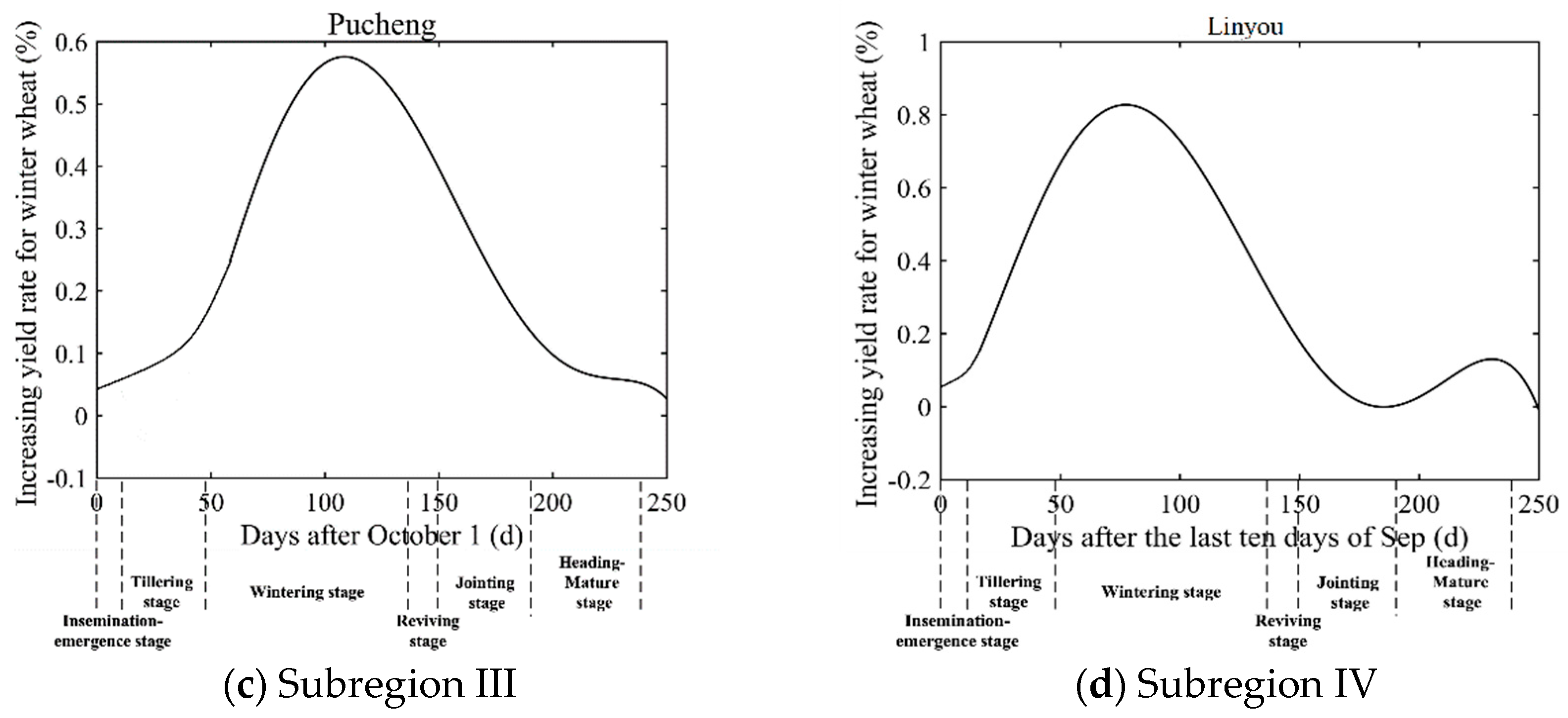
| Subregion | Precipitation/Evapotranspiration (%) | Evapotrans-Piration (mm) | Precipitation (mm) | Water Deficit (mm) | ||||||||
|---|---|---|---|---|---|---|---|---|---|---|---|---|
| Oct | Nov | Dec | Jan | Feb | Mar | Apr | May | The First 10 Days of Jun | ||||
| I | 68.8 | 68.7 | 90.3 | 32.8 | 40.4 | 30.3 | 31.4 | 20.4 | 49.4 | 485.8 | 187.4 | 298.4 |
| II | 80.6 | 81.5 | 41.9 | 26.2 | 52.7 | 46.0 | 51.4 | 34.9 | 63.1 | 481.5 | 229.1 | 202.4 |
| III | 92.5 | 62.7 | 25.0 | 10.9 | 30.9 | 25.2 | 42.1 | 39.5 | 50.2 | 480.1 | 216.1 | 264.0 |
| IV | 141.0 | 92.9 | 24.5 | 25.1 | 41.7 | 38.7 | 55.0 | 63.7 | 93.9 | 402.4 | 256.8 | 145.6 |
© 2019 by the authors. Licensee MDPI, Basel, Switzerland. This article is an open access article distributed under the terms and conditions of the Creative Commons Attribution (CC BY) license (http://creativecommons.org/licenses/by/4.0/).
Share and Cite
Wang, Y.; Yang, T.; Zhao, R.; Jiang, K.; Ma, X. A New Method for Determining Critical Irrigation Period for Large Regions Based on Precipitation-Meteorological Yield Integral Regression Relationship—A Case Study of Winter Wheat in Shaanxi Province, China. Appl. Sci. 2019, 9, 5181. https://doi.org/10.3390/app9235181
Wang Y, Yang T, Zhao R, Jiang K, Ma X. A New Method for Determining Critical Irrigation Period for Large Regions Based on Precipitation-Meteorological Yield Integral Regression Relationship—A Case Study of Winter Wheat in Shaanxi Province, China. Applied Sciences. 2019; 9(23):5181. https://doi.org/10.3390/app9235181
Chicago/Turabian StyleWang, Yongqiang, Ting Yang, Rongheng Zhao, Kongtao Jiang, and Xiaoyi Ma. 2019. "A New Method for Determining Critical Irrigation Period for Large Regions Based on Precipitation-Meteorological Yield Integral Regression Relationship—A Case Study of Winter Wheat in Shaanxi Province, China" Applied Sciences 9, no. 23: 5181. https://doi.org/10.3390/app9235181




